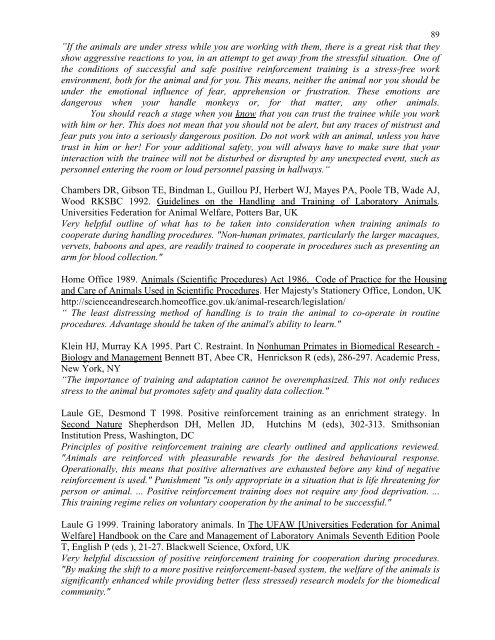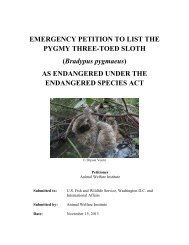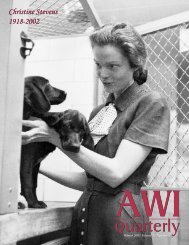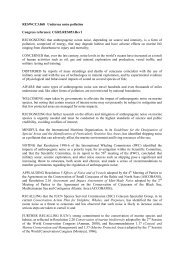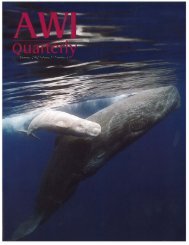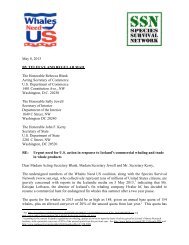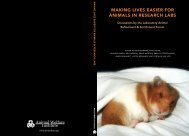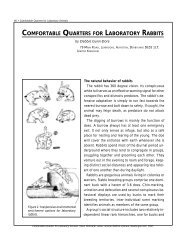89”If the animals are u<strong>nd</strong>er stress while you are working with them, there is a great risk that theyshow aggressive reactions to you, in an attempt to get away from the stressful situation. One ofthe co<strong>nd</strong>itions of successful a<strong>nd</strong> safe positive rein<strong>for</strong>ce<strong>ment</strong> training is a stress-free workenviron<strong>ment</strong>, both <strong>for</strong> the animal a<strong>nd</strong> <strong>for</strong> you. This means, neither the animal nor you should beu<strong>nd</strong>er the emotional influence of fear, apprehension or frustration. These emotions aredangerous when your ha<strong>nd</strong>le monkeys or, <strong>for</strong> that matter, any other animals.You should reach a stage when you know that you can trust the trainee while you workwith him or her. This does not mean that you should not be alert, but any traces of mistrust a<strong>nd</strong>fear puts you into a seriously dangerous position. Do not work with an animal, unless you havetrust in him or her! For your additional safety, you will always have to make sure that yourinteraction with the trainee will not be disturbed or disrupted by any unexpected event, such aspersonnel entering the room or loud personnel passing in hallways.“Chambers DR, Gibson TE, Bi<strong>nd</strong>man L, Guillou PJ, Herbert WJ, Mayes PA, Poole TB, Wade AJ,Wood RKSBC 1992. Guidelines on the Ha<strong>nd</strong>ling a<strong>nd</strong> Training of Laboratory Animals.Universities Federation <strong>for</strong> Animal Welfare, Potters Bar, UKVery helpful outline of what has to be taken into consideration when training animals tocooperate during ha<strong>nd</strong>ling procedures. "Non-human prim<strong>ates</strong>, particularly the larger macaques,vervets, baboons a<strong>nd</strong> apes, are readily trained to cooperate in procedures such as presenting anarm <strong>for</strong> blood collection."Home Office 1989. Animals (Scientific Procedures) Act 1986. Code of Practice <strong>for</strong> the Housinga<strong>nd</strong> Care of Animals Used in Scientific Procedures. Her Majesty's Stationery Office, Lo<strong>nd</strong>on, UKhttp://sciencea<strong>nd</strong>research.homeoffice.gov.uk/animal-research/legislation/“ The least distressing method of ha<strong>nd</strong>ling is to train the animal to co-operate in routineprocedures. Advantage should be taken of the animal's ability to learn."Klein HJ, Murray KA 1995. Part C. <strong>Re</strong>straint. In Nonhuman <strong>Prima</strong>tes in Biomedical <strong>Re</strong>search -Biology a<strong>nd</strong> Manage<strong>ment</strong> Bennett BT, Abee CR, Henrickson R (eds), 286-297. Academic Press,New York, NY“The importance of training a<strong>nd</strong> adaptation cannot be overemphasized. This not only reducesstress to the animal but promotes safety a<strong>nd</strong> quality data collection."Laule GE, Desmo<strong>nd</strong> T 1998. Positive rein<strong>for</strong>ce<strong>ment</strong> training as an enrich<strong>ment</strong> strategy. InSeco<strong>nd</strong> Nature Shepherdson DH, Mellen JD, Hutchins M (eds), 302-313. SmithsonianInstitution Press, Washington, DCPrinciples of positive rein<strong>for</strong>ce<strong>ment</strong> training are clearly outlined a<strong>nd</strong> applications reviewed."Animals are rein<strong>for</strong>ced with pleasurable rewards <strong>for</strong> the desired behavioural response.Operationally, this means that positive alternatives are exhausted be<strong>for</strong>e any ki<strong>nd</strong> of negativerein<strong>for</strong>ce<strong>ment</strong> is used." Punish<strong>ment</strong> "is only appropriate in a situation that is life threatening <strong>for</strong>person or animal. ... Positive rein<strong>for</strong>ce<strong>ment</strong> training does not require any food deprivation. ...This training regime relies on voluntary cooperation by the animal to be successful."Laule G 1999. Training laboratory animals. In The UFAW [Universities Federation <strong>for</strong> AnimalWelfare] Ha<strong>nd</strong>book on the Care a<strong>nd</strong> Manage<strong>ment</strong> of Laboratory Animals Seventh Edition PooleT, <strong>En</strong>glish P (eds ), 21-27. Blackwell Science, Ox<strong>for</strong>d, UKVery helpful discussion of positive rein<strong>for</strong>ce<strong>ment</strong> training <strong>for</strong> cooperation during procedures."By making the shift to a more positive rein<strong>for</strong>ce<strong>ment</strong>-based system, the welfare of the animals issignificantly enhanced while providing better (less stressed) research models <strong>for</strong> the biomedicalcommunity."
T-W-Fiennes RN 1972. <strong>Prima</strong>tes - General. In The UFAW Ha<strong>nd</strong>book on the Care a<strong>nd</strong>Manage<strong>ment</strong> of Laboratory Animals Fourth Edition Universities Federation <strong>for</strong> Animal Welfare(ed), 374-375. Churchill Livingstone, Lo<strong>nd</strong>on, UK“Chimpanzees a<strong>nd</strong> baboons, are intelligent a<strong>nd</strong> sensitive. If ha<strong>nd</strong>led with sympathy a<strong>nd</strong>u<strong>nd</strong>ersta<strong>nd</strong>ing they can become more than research tools - even cooperative partners inexperi<strong>ment</strong>ation. To achieve this, a little time .. must be spent on co<strong>nd</strong>itioning the animals. Achimpanzee, <strong>for</strong> instance, will sit quietly a<strong>nd</strong> hold his arm out <strong>for</strong> a blood sample to be taken. ...An animal treated unsympathetically is liable to become aggressive a<strong>nd</strong> uncooperative;furthermore, unless care is taken over its com<strong>for</strong>t a<strong>nd</strong> needs, it is liable to become stressed a<strong>nd</strong>the results of the experi<strong>ment</strong> may be vitiated <strong>for</strong> this reason."(3,2) Species-specific <strong>Re</strong>comme<strong>nd</strong>ationsBaboons (Papio spp.)Levison PK, Fester CB, Nieman WH, Fi<strong>nd</strong>ley JD 1964. A method <strong>for</strong> training unrestrainedprim<strong>ates</strong> to receive drug injection. Journal of the Experi<strong>ment</strong>al Analysis of Behavior 7, 253-254Training technique by which an adult, single-housed male baboon learned to offer his armthrough a pothole a<strong>nd</strong> accept intramuscular injection in this home cage is described a<strong>nd</strong> theresult demonstrated with a photo. Injection was reliably obtained after approximately nine onehourtraining sessions.Turkkan JS, Ator NA, et al 1989. Beyo<strong>nd</strong> chronic catheterization in laboratory prim<strong>ates</strong>. InHousing, Care a<strong>nd</strong> Psychological Well-being of Captive a<strong>nd</strong> Laboratory <strong>Prima</strong>tes Segal EF (ed),305-322. Noyes Publications, Park Ridge, NJTraining protocols are described to ensure cooperation of single-housed baboons during bloodpressure measure<strong>ment</strong> a<strong>nd</strong> during oral drug dosing in the homecage.Chimpanzees (Pan troglodytes)Bloomsmith MA, Laule GE, Al<strong>for</strong>d PL, Thurston RH 1994. Using training to moderatechimpanzee aggression during feeding. Zoo Biology 13, 557-566"Positive rein<strong>for</strong>ce<strong>ment</strong> training techniques were applied to reduce a dominant malechimpanzee's aggression a<strong>nd</strong> chasing during meals. Verbal comma<strong>nd</strong>s a<strong>nd</strong> food rein<strong>for</strong>cers wereused to train him to sit a<strong>nd</strong> remain seated while other group members received a<strong>nd</strong> ate theirshare of produce."Bloomsmith MA, Stone AM, Laule GE 1998. Positive rein<strong>for</strong>ce<strong>ment</strong> training to enhance thevoluntary move<strong>ment</strong> of group-housed chimpanzees within their enclosure. Zoo Biology 17, 333-341Positive rein<strong>for</strong>ce<strong>ment</strong> was applied to train groups of chimpanzees to move voluntarily into thei<strong>nd</strong>oor portions of their enclosures at the request of trainers a<strong>nd</strong> to be briefly restricted to thoseareas.Kessel-Davenport AL, Gutierrez T 1994. Training captive chimpanzees <strong>for</strong> move<strong>ment</strong> in atransport box. The Newsletter 6(2), 1-2http://www.awionline.org/Lab_animals/biblio/jo-6.htm90
- Page 3:
Table of ContentsSpecies-typical Be
- Page 7 and 8:
2Behavioral Pathologies (Abnormal B
- Page 9 and 10:
Meyerson BJ 1986. Ethology in anima
- Page 11 and 12:
6"An animal treated unsympathetical
- Page 13 and 14:
8"If sufficient room is not provide
- Page 15 and 16:
Canadian Council on Animal Care 198
- Page 17 and 18:
12Platt DM, Kinsey JH, Jorgenson MJ
- Page 19 and 20:
14(7) Enforced RestraintAdams MR, K
- Page 21 and 22:
16Goosen DJ, Davies JH, Maree M, Do
- Page 23 and 24:
Norman RL, McGlone J, Smith CJ 1994
- Page 25 and 26:
20Crockett CM, Bowers CL, Shimoji M
- Page 27 and 28:
22(10) Double-tier Cage Arrangement
- Page 29 and 30:
National Research Council 1998. The
- Page 31 and 32:
26Coe CL 1991. Is social housing of
- Page 33 and 34:
28Tatoyan SK, Cherkovich GM 1972. T
- Page 35 and 36:
30Line SW, Morgan KN, Markowitz H,
- Page 37 and 38:
32Reinhardt V 1989. Evaluation of t
- Page 39 and 40:
34Clarke AS, Juno CJ, Maple TL 1982
- Page 41 and 42:
36The animals “spent most time in
- Page 43 and 44: 38Brent L, Belik M 1997. The respon
- Page 45 and 46: 40"Access to the puzzles was accomp
- Page 47 and 48: 42"The purpose of this study was to
- Page 49 and 50: 44Choi GC 1993. Humans enrich the l
- Page 51 and 52: 46“Eleven baboons who had been si
- Page 53 and 54: 48Reinhardt V, Houser WD, Eisele S,
- Page 55 and 56: 50Thompson MA, Bloomsmith MA, Taylo
- Page 57 and 58: (7) Working with Cooperative Animal
- Page 59 and 60: 54Lambeth SP, Hau J, Perlman JE, Ma
- Page 61 and 62: 56Smith M, Barley J, Down N, Franci
- Page 63 and 64: Environmental Enrichment58(1) Defin
- Page 65 and 66: 60Baker KC, Seres M, Aureli F, de W
- Page 67 and 68: 62Judge PG, de Waal BM, Paul KS, Go
- Page 69 and 70: (2,1,b) Group-housing: Group Format
- Page 71 and 72: 66McNary JK 1992. Integration of ch
- Page 73 and 74: 68Clarke MR, Blanchard JL 1994. All
- Page 75 and 76: Watts E 1997. Introductions. In Ora
- Page 77 and 78: 72Baumans V, Coke C, Green J, Morea
- Page 79 and 80: 74Hotchkiss CE, Paule MG 2003. Effe
- Page 81 and 82: 76Reinhardt V, Hurwitz S 1993. Eval
- Page 83 and 84: 78Shively CA 2001. Psychological we
- Page 85 and 86: 80“The establishment of dominance
- Page 87 and 88: 82Reinhardt V 1991. Agonistic behav
- Page 89 and 90: Abney D, Conlee K, Cunneen M, Down
- Page 91 and 92: 86Boccia ML, Broussard C, Scanlan J
- Page 93: Southey ER, Baldwin CM 2006. Social
- Page 97 and 98: 927 to 44 training sessions. .. The
- Page 99 and 100: 94Baumans V, Coke C, Green J, Morea
- Page 101 and 102: 96Skoumbourdis EK 2008. Pole-and-co
- Page 103 and 104: 98Tamarins (Saguinus spp.)Smith TE,
- Page 105 and 106: 100Bertrand F, Seguin Y, Chauvier F
- Page 107 and 108: 102Gilloux I, Gurnell J, Shepherdso
- Page 109 and 110: 104Molzen EM, French JA 1989. The p
- Page 111 and 112: 106Reinhardt V 1992. Foraging for c
- Page 113 and 114: 108Boccia ML 1989. Long-term effect
- Page 115 and 116: 110Baumans V, Coke C, Green J, More
- Page 117 and 118: 112”We give our pair-housed cynos
- Page 119 and 120: 114use their hands to obtain and pr
- Page 121 and 122: 116MacLean E, Roberts Prior S 2006.
- Page 123 and 124: Bayne K, Hurst JK, Dexter SL 1992.
- Page 125 and 126: 120Phillippi-Falkenstein K 1998. Us
- Page 127 and 128: 122Shimoji M, Bowers CL, Crockett C
- Page 129 and 130: Anonymous 1991. The psychological w
- Page 131 and 132: 126Pruetz JD, Bloomsmith MA 1992. C
- Page 133 and 134: 128Reinhardt V 1990. Time budget of
- Page 135 and 136: 130O'Neill PL, Wright AC, Weed JL 1
- Page 137 and 138: 132above ground level. I very often
- Page 139 and 140: 134Canadian Council on Animal Care
- Page 141 and 142: 136International Primatological Soc
- Page 143 and 144: 138forage daily, by scattering food
- Page 145 and 146:
140sensory and emotional experience
- Page 147 and 148:
142Bayne K 1989 Resolving issues of
- Page 149 and 150:
144creation? Very unlikely!I think
- Page 151:
146Spaeth GL 1994. Editorial: Carin


